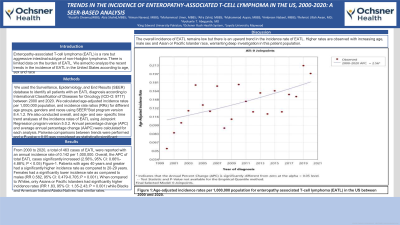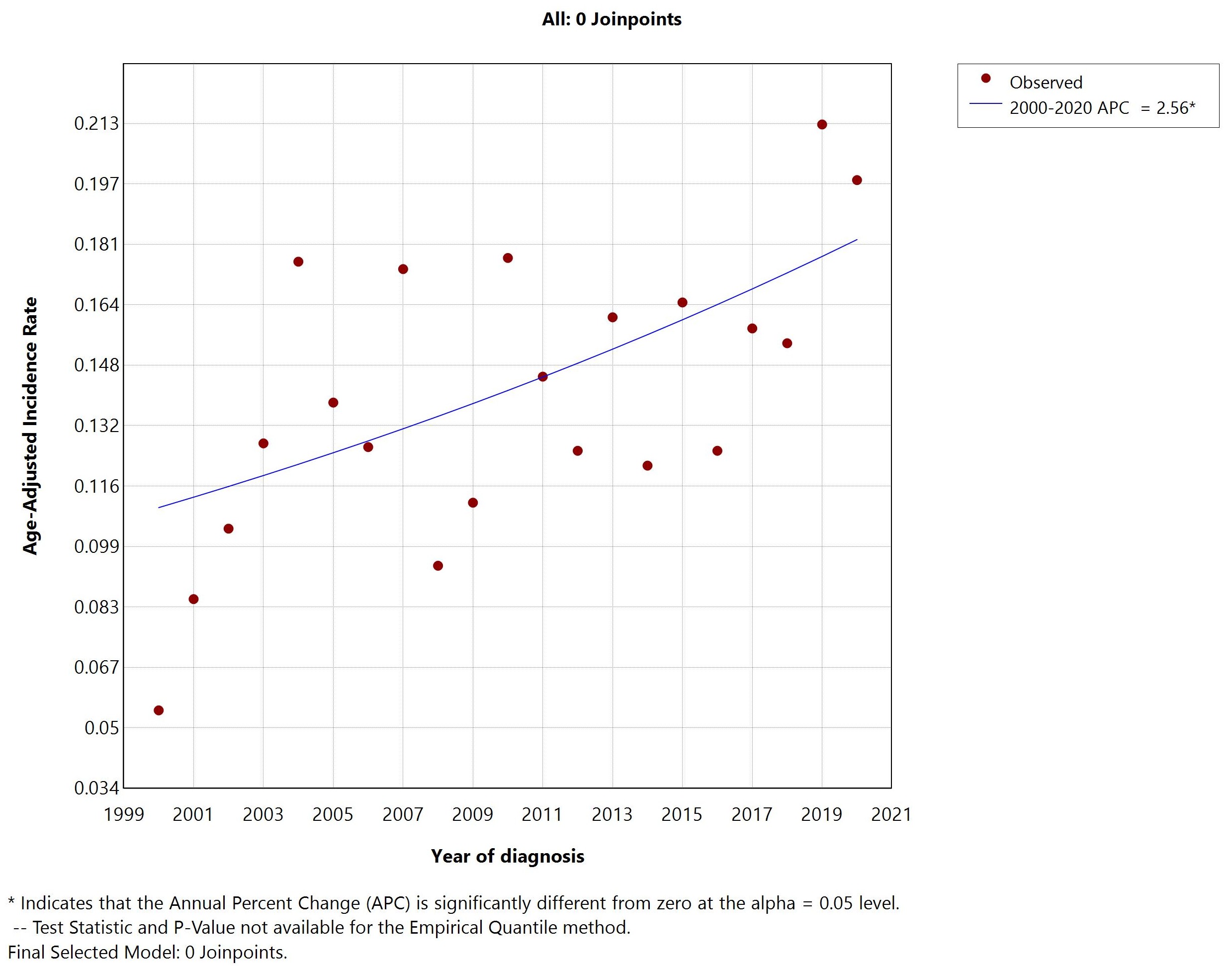Tuesday Poster Session
Category: Colon
P3024 - Trends in the Incidence of Enteropathy-Associated T-cell Lymphoma in the US, 2000-2020: A SEER-Based Analysis
Tuesday, October 24, 2023
10:30 AM - 4:00 PM PT
Location: Exhibit Hall

Has Audio
- AN
Ambreen Nabeel, MBBS
Ochsner Rush Medical Center
Meridian, MS
Presenting Author(s)
Huzaifa Ahmad Cheema, MBBS1, Abia Shahid, MBBS1, Aiman Naveed, MBBS1, Mohammad Umer, MBBS1, Afra Zahid, MBBS1, Muhammad Ayyan, MBBS1, Ambreen Nabeel, MBBS2, Rehmat Ullah Awan, MD2, Ayokunle T.. Abegunde, MD3
1King Edward Medical University, Lahore, Punjab, Pakistan; 2Ochsner Rush Medical Center, Meridian, MS; 3Loyola University Medical Center, Maywood, IL
Introduction: Enteropathy-associated T-cell lymphoma (EATL) is a rare but aggressive intestinal subtype of non-Hodgkin lymphoma. There is limited data on the burden of EATL. We aimed to analyze the recent trends in the incidence of EATL in the United States according to age, sex and race
Methods: We used the Surveillance, Epidemiology, and End Results (SEER) database to identify all patients with an EATL diagnosis according to International Classification of Diseases for Oncology (ICD-O: 9717) between 2000 and 2020. We calculated age-adjusted incidence rates per 1,000,000 population, and incidence rate ratios (RRs) for different age groups, genders and races using SEER*Stat program version 8.4.1.2. We also conducted overall, and age- and sex- specific time trend analyses of the incidence rates of EATL using Joinpoint Regression program version 5.0.2. Annual percentage change (APC) and average annual percentage change (AAPC) were calculated for each analysis. Pairwise comparisons between trends were performed and a P-value < 0.05 was considered as statistically significant.
Results: From 2000 to 2020, a total of 463 cases of EATL were reported with an annual incidence rate of 0.142 per 1,000,000. Overall, the APC of total EATL cases significantly increased (2.56%, 95% CI: 0.66%-4.88%; P < 0.05) Figure-1. Patients with ages 40 years and greater had a significantly higher incidence rate as compared to 20-29 years. Females had a significantly lower incidence rate as compared to males (RR 0.582, 95% CI: 0.479-0.705; P < 0.001). When compared to Whites, only Asians or Pacific Islanders had significantly higher incidence rates (RR 1.83, 95% CI: 1.35-2.43; P < 0.001) while Blacks and American Indians/Alaska Natives had similar rates.
Discussion: The overall incidence of EATL remains low but there is an upward trend in the incidence rate of EATL. Higher rates are observed with increasing age, male sex and Asian or Pacific Islander race, warranting deep investigation in this patient population.

Disclosures:
Huzaifa Ahmad Cheema, MBBS1, Abia Shahid, MBBS1, Aiman Naveed, MBBS1, Mohammad Umer, MBBS1, Afra Zahid, MBBS1, Muhammad Ayyan, MBBS1, Ambreen Nabeel, MBBS2, Rehmat Ullah Awan, MD2, Ayokunle T.. Abegunde, MD3. P3024 - Trends in the Incidence of Enteropathy-Associated T-cell Lymphoma in the US, 2000-2020: A SEER-Based Analysis, ACG 2023 Annual Scientific Meeting Abstracts. Vancouver, BC, Canada: American College of Gastroenterology.
1King Edward Medical University, Lahore, Punjab, Pakistan; 2Ochsner Rush Medical Center, Meridian, MS; 3Loyola University Medical Center, Maywood, IL
Introduction: Enteropathy-associated T-cell lymphoma (EATL) is a rare but aggressive intestinal subtype of non-Hodgkin lymphoma. There is limited data on the burden of EATL. We aimed to analyze the recent trends in the incidence of EATL in the United States according to age, sex and race
Methods: We used the Surveillance, Epidemiology, and End Results (SEER) database to identify all patients with an EATL diagnosis according to International Classification of Diseases for Oncology (ICD-O: 9717) between 2000 and 2020. We calculated age-adjusted incidence rates per 1,000,000 population, and incidence rate ratios (RRs) for different age groups, genders and races using SEER*Stat program version 8.4.1.2. We also conducted overall, and age- and sex- specific time trend analyses of the incidence rates of EATL using Joinpoint Regression program version 5.0.2. Annual percentage change (APC) and average annual percentage change (AAPC) were calculated for each analysis. Pairwise comparisons between trends were performed and a P-value < 0.05 was considered as statistically significant.
Results: From 2000 to 2020, a total of 463 cases of EATL were reported with an annual incidence rate of 0.142 per 1,000,000. Overall, the APC of total EATL cases significantly increased (2.56%, 95% CI: 0.66%-4.88%; P < 0.05) Figure-1. Patients with ages 40 years and greater had a significantly higher incidence rate as compared to 20-29 years. Females had a significantly lower incidence rate as compared to males (RR 0.582, 95% CI: 0.479-0.705; P < 0.001). When compared to Whites, only Asians or Pacific Islanders had significantly higher incidence rates (RR 1.83, 95% CI: 1.35-2.43; P < 0.001) while Blacks and American Indians/Alaska Natives had similar rates.
Discussion: The overall incidence of EATL remains low but there is an upward trend in the incidence rate of EATL. Higher rates are observed with increasing age, male sex and Asian or Pacific Islander race, warranting deep investigation in this patient population.

Figure: Age-adjusted incidence rates per 1,000,000 population for enteropathy associated T-cell lymphoma (EATL) in the US between 2000 and 2020.
Disclosures:
Huzaifa Ahmad Cheema indicated no relevant financial relationships.
Abia Shahid indicated no relevant financial relationships.
Aiman Naveed indicated no relevant financial relationships.
Mohammad Umer indicated no relevant financial relationships.
Afra Zahid indicated no relevant financial relationships.
Muhammad Ayyan indicated no relevant financial relationships.
Ambreen Nabeel indicated no relevant financial relationships.
Rehmat Ullah Awan indicated no relevant financial relationships.
Ayokunle Abegunde indicated no relevant financial relationships.
Huzaifa Ahmad Cheema, MBBS1, Abia Shahid, MBBS1, Aiman Naveed, MBBS1, Mohammad Umer, MBBS1, Afra Zahid, MBBS1, Muhammad Ayyan, MBBS1, Ambreen Nabeel, MBBS2, Rehmat Ullah Awan, MD2, Ayokunle T.. Abegunde, MD3. P3024 - Trends in the Incidence of Enteropathy-Associated T-cell Lymphoma in the US, 2000-2020: A SEER-Based Analysis, ACG 2023 Annual Scientific Meeting Abstracts. Vancouver, BC, Canada: American College of Gastroenterology.
